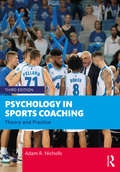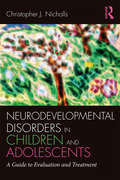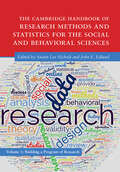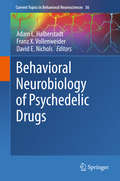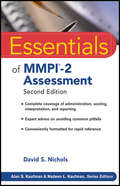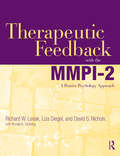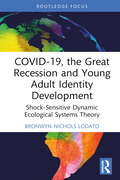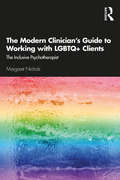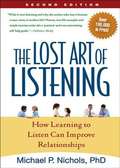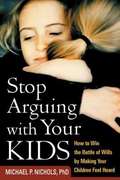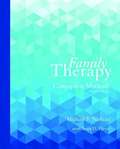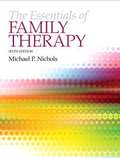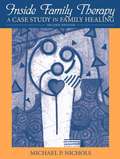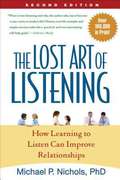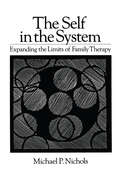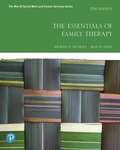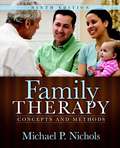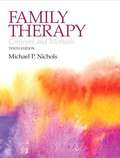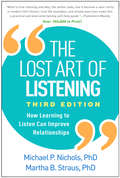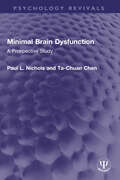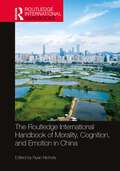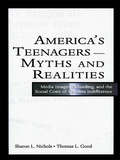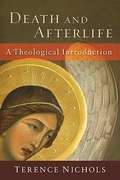- Table View
- List View
Psychology in Sports Coaching: Theory and Practice
by Adam R. NichollsThe most effective coaches understand the fundamentals of sport psychology, which include interacting effectively with athletes, creating the optimal environment, assessing the psychological needs of their athletes, and providing them with the mental training required to maximise performance. Fully revised and updated, the third edition of Psychology in Sports Coaching clearly and accessibly introduces the principles and practice of sport psychology in the context of the coaching process. Drawing on the very latest research and theory, the book introduces the psychological tools and techniques that coaches can use to get the best performances out of their athletes. Including three new chapters on the constraints approach to assessing psychological needs, mental imagery, managing perfectionism tendencies, and mentoring leaders, the book also offers step-by-step guidance on key topics such as: Assessing the needs of athletes Facilitating awareness through goal setting and performance profiling Coaching specialist populations effectively (e.g. children, adolescents, adults and athletes with learning disabilities) Reducing favourable attitudes towards doping Developing effective coach-athlete relationships Reducing choking under pressure Mindfulness techniques Mental imagery Every chapter contains useful features to aid learning and understanding, including in-depth case studies, critical thinking questions, clear and concise summaries, and practice exam questions. Psychology in Sports Coaching is essential reading for any student of sports coaching, or any practising coach looking to extend and develop their skills, and useful applied reading for students of sport psychology.
Neurodevelopmental Disorders in Children and Adolescents: A Guide to Evaluation and Treatment (Clinical Topics in Psychology and Psychiatry)
by Christopher J. NichollsNeurodevelopmental Disorders in Children and Adolescents provides an innovative perspective on developmental disorders in youth, one focused on embracing and working with the "messiness" and many variables at play in child and adolescent development. The volume’s approach is aligned with the NIMH Research Domain Criteria project, which hopes to move away from categorical diagnosis toward multidimensional analysis. Each chapter focuses on a particular aspect of development, cluster of diagnoses, or clinical concern. The book also emphasizes humility, an awareness of diversity and difference without stigma, and support for collaborative and integrative healthcare. This is an essential volume for practitioners hoping to improve how they evaluate and treat developmental disorders in children.
The Cambridge Handbook of Research Methods and Statistics for the Social and Behavioral Sciences: Volume 1: Building a Program of Research (Cambridge Handbooks in Psychology)
by Austin Lee Nichols John E. EdlundThe first of three volumes, the five sections of this book cover a variety of issues important in developing, designing, and analyzing data to produce high-quality research efforts and cultivate a productive research career. First, leading scholars from around the world provide a step-by-step guide to doing research in the social and behavioral sciences. After discussing some of the basics, the various authors next focus on the important building blocks of any study. In section three, various types of quantitative and qualitative research designs are discussed, and advice is provided regarding best practices of each. The volume then provides an introduction to a variety of important and cutting-edge statistical analyses. In the last section of the volume, nine chapters provide information related to what it takes to have a long and successful research career. Throughout the book, example and real-world research efforts from dozens of different disciplines are discussed.
Behavioral Neurobiology of Psychedelic Drugs (Current Topics In Behavioral Neurosciences Ser. #36)
by David E. Nichols Franz X. Vollenweider Adam L. HalberstadtThis volume brings together the latest basic and clinical research examining the effects and underlying mechanisms of psychedelic drugs. Examples of drugs within this group include LSD, psilocybin, and mescaline. Despite their structural differences, these compounds produce remarkably similar experiences in humans and share a common mechanism of action. Commonalities among the substances in this family are addressed both at the clinical and phenomenological level and at the basic neurobiological mechanism level. To the extent possible, contributions relate the clinical and preclinical findings to one another across species. The volume addresses both the risks associated with the use of these drugs and the potential medical benefits that might be associated with these and related compounds.
Essentials of MMPI-2 Assessment
by David S. Nichols Alan S. KaufmanQuickly acquire the knowledge and skills you need toconfidently administer, score, and interpret the MMPI®-2The Minnesota Multiphasic Personality Inventory-2 (MMPI®-2) is the most widely used test in the world for personality assessment. To use it properly, professionals need an authoritative source of advice and guidance on how to administer, score, and interpret this test. Now thoroughly updated to reflect the latest research and literature on this test, Essentials of MMPI®-2 Assessment, Second Edition is that source.Like all the volumes in the Essentials of Psychological Assessment series, this book is designed to help busy mental health professionals, and those in training, quickly acquire the knowledge and skills they need to make optimal use of major psychological assessment instruments. Each concise chapter features numerous callout boxes highlighting key concepts, bulleted points, and extensive illustrative material, as well as test questions that help you gauge and reinforce your grasp of the information covered.Essentials of MMPI®-2 Assessment, Second Edition adds new material on the MMPI®-2 RC and the MMPI®-2 RF, providing step-by-step guidance on test administration, scoring, and interpretation. Additionally, the author provides his expert assessment of the test's relative strengths and weaknesses, valuable advice on its clinical applications, and several illuminating case reports.
Therapeutic Feedback with the MMPI-2: A Positive Psychology Approach
by David S. Nichols Richard W. Levak Liza SiegelTherapeutic Feedback with the MMPI-2 provides the clinician with empirically-based, practical information about how to convey the abundance of information in the MMPI-2 profile in a way that is collaborative, empathic, hopeful, and facilitates a therapeutic alliance. Readers will find this book to be as useful and applicable as the MMPI-2 itself, which is used in psychiatric hospitals; correctional settings; in evaluations for job selection, general medicine, forensic and child custody cases; and even in screenings for television, game, and reality shows. The authors expand upon this already robust test by demonstrating how therapeutic assessment and feedback can be improved upon by considering three contributions from positive psychology: that behavior can be viewed as potentially adaptive; traditional pathological and maladaptive behaviors can be reframed as understandable responses to stressors that therapeutic feedback is empathic, nonjudgmental, and mostly jargon free; humans respond to overwhelming stress in understandable ways that the therapist can give coherence and meaning to lastly, that therapeutic feedback stresses self-esteem and resilience building through self-awareness as a goal. Discussion centers around ten scales and 27 common code types. Each section addresses the complaints, thoughts, emotions, traits and behaviors associated with the profile; therapists’ notes; lifestyle and family background; modifying scales; therapy and therapeutic pitfalls; feedback statements; and treatment and self-help suggestions. The larger page size reflects the size of the MMPI-2 interpretive reports and makes it easy for clinicians to copy pages of the book to share with their clients. Therapeutic Feedback with the MMPI-2 is the most detailed volume available on MMPI-2 feedback and is a valuable addition to the bookshelf of any clinician who uses this test.
COVID-19, the Great Recession and Young Adult Identity Development: Shock-Sensitive Dynamic Ecological Systems Theory (ISSN)
by Bronwyn Nichols LodatoThis book offers a paradigm shift in the framing of identity development by advancing a new, shock-sensitive framework for diverse young adult identity development after high school.The author builds on the critical theoretical contributions of Urie Bronfenbrenner and Margaret Beale Spencer that highlight the person-context nature of development and the dynamic nature of vulnerability, risk, and coping. The inclusive, policy-relevant theoretical approach emerges from the author’s mixed-methods study that examines the context-dependent identity development experiences of young adults. The book also accounts for the unique person-context dynamics during the Great Recession and COVID-19 global shocks that drive how diverse young adults make meaning of risk as they cope with the shock-related disruptions on their individual postsecondary journeys toward building their adult identities. Given that the qualitative interview component of the study occurred during the COVID-19 pandemic, this research offers a unique, in-real-time vantage point from participants who are making meaning of their choices and decisions as the shock was underway. The book also tracks the heightened importance of online tools during this period and the implications of virtual contexts where developmental activities are pursued, such as online education, work, and socializing.Advancing a new, shock-sensitive, interdisciplinary theory of identity development in postsecondary journeys of diverse young adults, it will appeal to scholars and students at the graduate level working across psychology, human development, educational psychology, sociology of education, and public policy.
The Modern Clinician's Guide to Working with LGBTQ+ Clients: The Inclusive Psychotherapist
by Margaret NicholsThe Modern Clinician's Guide to Working with LGBTQ+ Clients is a ground-breaking resource for therapists working with LGBTQ+ clients whose identity expressions span all gender-, sex-, and relationship-diverse groups. Combining the author’s extensive clinical experience with contemporary evidence-based research, the chapters of this book explore the origins and development of sexual minority groups, going beyond lesbian women and gay men to include transgender and gender nonbinary people, kink and polyamory, bisexuality and pansexuality, and those who identify as asexual or aromantic. The text also offers in-depth coverage of clinical work with transgender, gender-nonconforming, and nonbinary clients of all ages. With a wealth of therapeutic strategies and case studies, this resource helps professionals respond to this ‘Big Tent’ community in an informed and empathetic way. Spanning sexuality, gender, relationships and age groups, The Modern Clinician's Guide to Working with LGBTQ+ Clients is an invaluable reference for psychotherapists in a broad range of clinical settings.
Lost Art of Listening, Second Edition
by Michael NicholsOne person talks; the other listens. It's so basic that we take it for granted. Unfortunately, most of us think of ourselves as better listeners than we actually are. Why do we so often fail to connect when speaking with family members, romantic partners, colleagues, or friends? How do emotional reactions get in the way of real communication? This thoughtful, witty, and empathic book has already helped over 100,000 readers break through conflicts and transform their personal and professional relationships. Experienced therapist Mike Nichols provides vivid examples, easy-to-learn techniques, and practical exercises for becoming a better listener--and making yourself heard and understood, even in difficult situations.
Stop Arguing with Your Kids
by Michael NicholsFor parents fed up with constant challenges to their authority-but who dread becoming tyrants in their own homes-this book provides a powerful new alternative to "because I said so." Trusted family therapist and author Michael P. Nichols takes on the number-one problem of parents today with the insight and humor that has made his earlier The Lost Art of Listening an enduring bestseller. Presented is a simple, easy-to-follow, yet remarkably effective way to put an end to arguments by refusing to argue back. Instead, the techniques of responsive listening help parents open up better communication in the family; create an atmosphere of respect and cooperation; and take children's feelings into account-without giving in to their demands. Loads of realistic examples help parents defuse whining and defiance and manage common conflicts with preschoolers to teens.
Family Therapy: Concepts and Methods
by Michael Nichols Sean DavisLong considered the standard of excellence--the best introduction and guide to the practice of family therapy available--this accessible resource explores the rich history and contemporary practice of the entire field. Thorough, thoughtful, fair, and balanced, Family Therapy by Michael P. Nichols presents ideas and techniques that give readers a clear focus on clinical practice. While exploring the history, the classic schools, and the latest developments, this new edition puts an increased, pragmatic focus on clinical practice, which includes discussions of the author's observations of actual sessions with leading practitioners, as well as the best case studies of several invited master therapists. Included are video links, interactive chapter quizzes, new case studies, a new section on the impact of the Affordable Care Act, and many more content changes that bring the reader up to date on the latest and most critical issues in the field of family therapy today. The Enhanced Pearson eText features embedded videos and assessments
The Essentials of Family Therapy (Sixth Edition)
by Michael P. NicholsIllustrates family therapy techniques. With its clinical focus and extremely practical presentation, The Essentials of Family Therapy, 6/e examines the rich history, classic schools, and latest developments in family therapy. The sixth edition is edited to focus more on the contemporary clinical practice and case studies illustrating family therapy techniques. Written by a leading family therapist, descriptions of the various models are based on actual experience. Learning Goals Upon completing this book, readers will be able to: Utilize various family therapy techniques. Recognize the techniques of successful contemporaries in the field. Understand why research has failed to influence clinical practice.
Inside Family Therapy (Second Edition): A Case Study In Family Healing
by Michael P. NicholsFollow a family therapist's narrative diary as he documents the process of working with the Salazars, as they explore each stage of their relationship-from courtship through the departure of the children from the home.This unique casebook provides an in-depth, personal account from the counselor's perspective, while also looking at the personal viewpoints of family members. Each major stage of the family life is presented in a separate chapter and the book includes discussions of the effects of gender, ethnicity, and sexual orientation on individuals and families. What Reviewers Are Saying: "Strengths include presentation of therapy scenarios; focus on one family going through the therapy to demonstrate the stages of therapy and the stages of family life; real life experiences of the Salazar family members (students get inducted into this and usually 'read ahead' of what is assigned, something not normally done!).""William Quinn, Clemson University" "The Inside Family Therapy book is perfect. What is so very impressive about the content and the writing style is how Mike Nichols weaves and threads ways of thinking as he sits with this family, along with specific skills he utilizes in his work with them. It allows students to see and experience what is going on within Nichols and how that is played out in what he says and does with the family. This is not an easy thing to do with the written word (except in novels) but he does it so very well. It also leads to much greater self awareness on the part of the students. "Robert Jackson, University of Iowa"
The Lost Art of Listening: How Learning to Listen Can Improve Relationships (2nd edition)
by Michael P. NicholsNichols (psychology, College of William and Mary) provides a thoughtful guide to the art of listening, addressing the reasons why we so often fail to listen attentively to others, as well as providing strategies for getting oneself heard. Clear examples demonstrate techniques for better communication in both personal and professional relationships. Lacks an index and a bibliography. Annotation c. by Book News, Inc. , Portland, Or.
Lost Art of Listening, Second Edition
by Michael P. NicholsOne person talks; the other listens. It's so basic that we take it for granted. Unfortunately, most of us think of ourselves as better listeners than we actually are. Why do we so often fail to connect when speaking with family members, romantic partners, colleagues, or friends? How do emotional reactions get in the way of real communication? This thoughtful, witty, and empathic book has already helped over 100,000 readers break through conflicts and transform their personal and professional relationships. Experienced therapist Mike Nichols provides vivid examples, easy-to-learn techniques, and practical exercises for becoming a better listener--and making yourself heard and understood, even in difficult situations.
Lost Art of Listening, Second Edition
by Michael P. NicholsOne person talks; the other listens. It's so basic that we take it for granted. Unfortunately, most of us think of ourselves as better listeners than we actually are. Why do we so often fail to connect when speaking with family members, romantic partners, colleagues, or friends? How do emotional reactions get in the way of real communication? This thoughtful, witty, and empathic book has already helped over 100,000 readers break through conflicts and transform their personal and professional relationships. Experienced therapist Mike Nichols provides vivid examples, easy-to-learn techniques, and practical exercises for becoming a better listener--and making yourself heard and understood, even in difficult situations.
Self In The System: Expanding The Limits Of Family Therapy
by Michael P. NicholsFirst published in 1988. Routledge is an imprint of Taylor & Francis, an informa company.
The Essentials of Family Therapy
by Michael P. Nichols Sean D. DavisThe Context of Family Therapy, The Classic Schools of Family Therapy, Recent Developments in Family Therapy, The Evaluation of Family Therapy.
Family Therapy: Concepts and Methods (9th Edition)
by Michael P. Nichols Richard C. SchwartzFamily Therapy: Concepts and Methods is the definitive, classic in the field and covers all the major schools and developments in Family Therapy. Just some of the features that make this book so widely used -- Brief biographies and photos of some of the leading family therapists of the twentieth century; Extensive coverage of professional ethics, reflecting the need for students to have increased awareness of professional issues in family therapy; Unique issues family therapists encounter when providing home-based services; Latest research and data - often before that research is published in other forums. The Ninth Edition continues this tradition with many exciting revisions including: several new case studies a new summary of major theoretical concepts a new section on working with common forms of family triangles new sections on Sex and the Internet and Neuroscience and Relationships and much more! From the Preface - "One thing that tends to get lost in academic discussions of family therapy is the feeling of accomplishment that comes from sitting down with an unhappy family and being able to help them. Beginning therapists are understandably anxious and not sure they'll know how to proceed. ("How do you get all of them to come in?") Veterans often speak in abstractions. They have opinions and discuss big issues-postmodernism, narrative reconstructionism, second-order cybernetics. While it's tempting to use this space to say Important Things, I prefer to be a little more personal. Treating troubled families has given me the greatest satisfaction imaginable, and I hope that the same is or will be true for you." - Michael P. Nichols
Family Therapy: Concepts and Methods (10th Edition)
by Michael P. Nichols Richard C. SchwartzMike Nichols' engaging yet thorough guide has long been the standard in family therapy. The author describes and analyzes the field of family therapy, covering its history, schools, and developments. Numerous cases help readers appy theories to real situations and make the text even more engaging. Upon completing this book, readers will be able to: Describe clinical approaches Understand old and new developments in the field of family therapy Analyze successes and failures in research and the impact on current clinical practices Compare different schools of family therapy and explain the contemporary status of distinct schools of therapy
The Lost Art of Listening, Third Edition: How Learning to Listen Can Improve Relationships (Guilford Family Therapy Ser.)
by Michael P. Nichols Martha B. Straus"That isn't what I meant!" Truly listening and being heard is far from simple, even between people who care about each other. This perennial bestseller--now revised and updated for the digital age--analyzes how any conversation can go off the rails and provides essential skills for building mutual understanding. Thoughtful, witty, and empathic, the book is filled with vivid stories of couples, coworkers, friends, and family working through tough emotions and navigating differences of all kinds. Learn ways you can: *Hear what people mean, not just what they say. *Share a difference of opinion without sounding dismissive. *Encourage uncommunicative people to open up. *Make sure both sides get heard in heated discussions. *Get through to someone who never seems to listen. *Ask for support without getting unwanted advice. *Reduce miscommunication in texts and online. From renowned therapist Michael P. Nichols and new coauthor Martha B. Straus, the third edition reflects the huge impact of technology and social media on relationships, and gives advice for talking to loved ones across social and political divides
Minimal Brain Dysfunction: A Prospective Study (Psychology Revivals)
by Paul L. Nichols Ta-Chuan ChenThe concept of Minimal Brain Dysfunction (a previous term for ADHD) has had a tumultuous, and some would say, checkered history. Originally published in 1981, this title was one of a series of volumes dealing with specific developmental problems in children whose mothers registered for prenatal care in the Collaborative Perinatal Project (NCPP) of the National Institute of Neurological and Communicative Disorders and Stroke (NINCDS). In this volume, relationships between symptoms of minimal brain dysfunction and more than 300 prenatal and postnatal variables are examined in a cohort of nearly 30,000 7-year-old children. Despite greater understanding more recently, diagnosis and treatment continue to cause controversy. This is an early investigation into the concept of MBD and its causes, today it can be read in its historical context.
The Routledge International Handbook of Morality, Cognition, and Emotion in China (Routledge International Handbooks)
by Ryan NicholsThis ground-breaking handbook provides multi-disciplinary insight into Chinese morality, cognition and emotion by collecting in one place a comprehensive collection of essays focused on Chinese morality by world-leading experts from more than a dozen different academic fields of study. Through fifteen substantive chapters, readers are offered a holistic look into the ways morality could be interpreted in China, and a broad range of theoretical perspectives, including ecological, anthropological and cultural neuroscience. Offering a syncretic, multi-disciplinary overview that moves beyond the usual western-oriented perspective of China as a monolithic culture, research questions addressed in this book focus on morality as represented at the level of the individual, rather than at the group or institutional levels. Research questions explored herein include: What are the major contours of distinctively Chinese morality? What was the role of the ancient ecology, climate, and pathogen load in producing Chinese moral attitudes and emotions? Are ingredients of the good life in China different than ingredients of the good life elsewhere? How are children in China morally educated? How do findings from cultural neuroscience help us understand differences in the treatment of family members, or the treatment of strangers, in China and elsewhere? How do the protests in Hong Kong participate in, or stand apart from, the ongoing ethics of protest in historical China? The clear structure and accessible writing offer a rigorous assessment of the ways in which morality can be interpreted, shedding light on differences between China and Western cultures. The book also provides a timely window into Chinese forms of morality, and the pivotal role these play in social organization, family relationships, systems of government, emotion and cognition. Representing fields of study ranging from philosophy, linguistics, archaeology, history, and religion, to social psychology, neuroscience, clinical psychology, developmental psychology, and behavioral ecology, this is an essential text for students, academics, and others with wide interest in Chinese culture.
America's Teenagers--Myths and Realities: Media Images, Schooling, and the Social Costs of Careless Indifference
by Sharon L. Nichols Thomas L. GoodThe media's presentation suggests that American teenage culture today is the most violent, sexual, and amoral youth culture in history. In this book, Nichols and Good deconstruct the negative images held by large numbers of adults. Recognizing that many teenagers are left by adults to socialize themselves and the consequences of this "careless indifference," the authors' goal is to influence a more positive view leading to stronger social policies and better services, resources, and programs to meet the needs of America's youth. Unique features of America's Teenagers--Myths and Realities: Media Images, Schooling, and the Social Costs of Careless Indifference include:*powerful analytic lenses used to revisit typical depictions of youth;*a wealth of information brought to bear on understanding teenagers' behavior; and*consideration of a broad range of adolescent behaviors across critical socializing settings. The book begins with a discussion of the continuing myth of adolescence--how and why youth are devalued, and an overview of current beliefs about youth drawn from two 1990s Public Agenda Polls. This is followed by chapters on youth and the media, and the pressures that youth face in various dimensions of their lives. Topics include youth violence; the sex lives of teenagers; tobacco, alcohol, drugs, and teens; healthy living and decision making; working teens; and youth and education. The concluding chapter pulls together themes generated throughout the book and provides examples of policies that would underscore the value of viewing youth as a social investment. General guidelines are provided for teachers, parents, policymakers, and citizens to facilitate responding to youth in meaningful, proactive ways that improve the quality of life for teenagers and the broader society.
Death And Afterlife: A Theological Introduction
by Terence NicholsMany people fear dying and are uncertain about life after death. In this engaging book, a Catholic theologian addresses perennial human questions about death and what lies beyond, making a Christian case for an afterlife with God. Nichols begins by examining views of death and the afterlife in Scripture and the Christian tradition. He takes up scientific and philosophical challenges to the afterlife and considers what we can learn about it from near death experiences. Nichols then addresses topics such as the soul, bodily resurrection, salvation, heaven, hell, and purgatory. Finally, he addresses the important issue of preparing for death and dying well.
